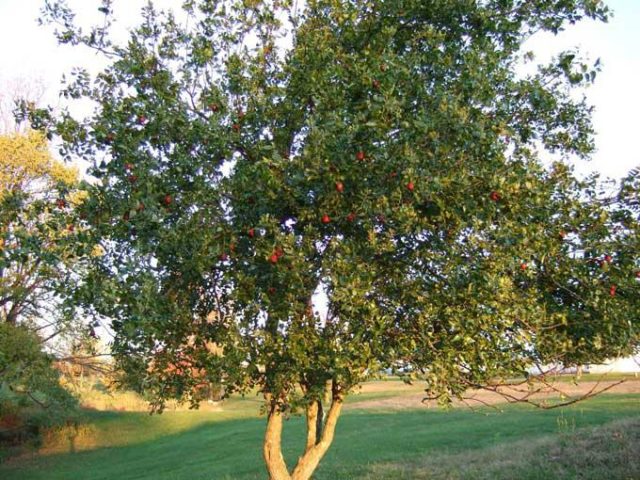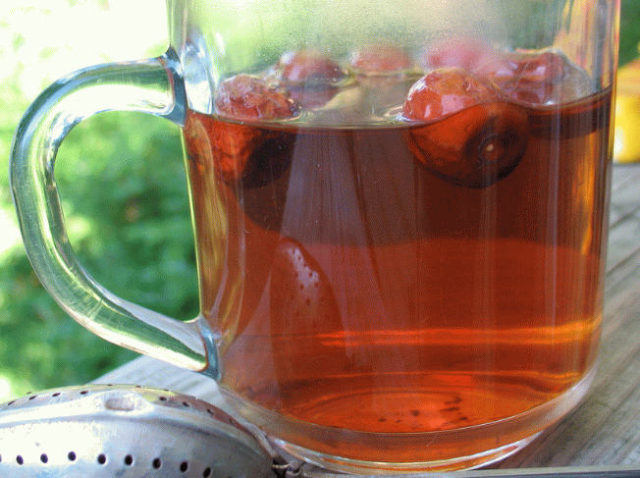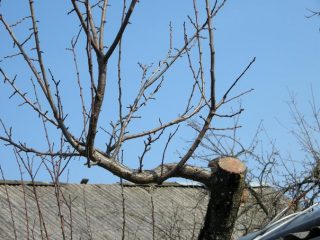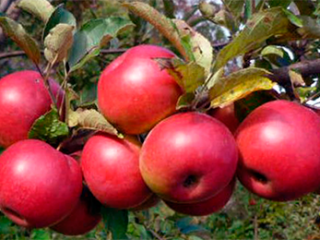Content
The healing properties of the Chinese unabi date are well known in the east. There, various parts of the plant have been used for thousands of years to treat mental and physical ailments, achieving impressive results. In the southern regions of the countries of the former Soviet Union, the traditions are not so ancient, but even there the beneficial properties and contraindications of jujube are known. Crimean sanatoriums, for example, recommend that hypertensive patients, instead of taking medications, eat 20 fresh small unabi fruits three times a day after meals.
What is "unabi"
Ziziphus jujuba or Real Ziziphus is a species of the genus Ziziphus, family Buckthorn (Zhosteraceae). It is known by different names - jujube or jujuba, Chinese date, hinap, unabi, juju. Sometimes on the Internet, jojoba is added to the list for unknown reasons. But this plant has so little in common with jujube that they are united only by the class – Dicotyledons.
Photo of Chinese date unabi
What does jujube look like?
Unabi is a large bush or small tree 5-12 m high with an openwork spreading crown. This is a branching species, in which only skeletal shoots are permanent, characterized by thick, dark, smooth bark, which cracks with age. The fruit branches are burgundy, fall off at the end of autumn, and grow back in the spring. In species of jujubes and some varieties they are covered with spines.
Jujube leaves are 3 to 7 cm long, 1-2 cm wide, and have the shape of an elongated oval with a pointed tip and a rounded base. To the touch they are quite dense, glossy, distinguished by two pronounced longitudinal stripes framing the central vein.
The greenish-yellow flowers of unabi have an original star-shaped shape. At the end of spring or beginning of summer, when the buds bloom, they densely dot the young branches, last a long time, and do not open at the same time. The flowering period is extended over two or three months, which only adds to the decorative appearance of the plant.
Photo of jujube tree (unabi) during flowering and beginning of fruiting
Jujube fruits are a drupe with two seeds. In species plants, their length reaches 2 cm and their weight is 25 g. Varietal unabi can be twice as heavy and reach a size of 5 cm.Their shape is varied - almost round, oval, pear-shaped, but the color always changes from greenish-yellow to brown, only the shade differs. Sometimes jujube fruits are covered with characteristic speckles.
Unripe unabi can be juicy and have an apple flavor. After full ripening, their pulp becomes mealy and very sweet, which is why jujube is often called the Chinese date.
Due to extended flowering, unabi fruits ripen at different times. They begin to be collected in October and are finished just before frost. Even fully ripe jujube fruits hang on the branches for a long time - there they wither, but this only makes them tastier.
In the fifth zone or in a rainy summer, unabi may not have time to fully ripen. Then they are collected greenish and “finished” in a closed, warm room.
Unabi grown from a seed begins to bear fruit after 3-4 years. The grafted variety can bloom the next season. Jujube lives up to 100 years, 50 of which bear fruit regularly and abundantly, another 25-30 - yielding more than 50% of the possible harvest.
Photo of unabi fruits
How it grows
For normal growth and fruiting, jujube needs hot, dry weather in summer, cool weather in winter. During the dormant period, the most comfortable temperature is slightly above or below 0° C. In regions with hot and harsh winters, unabi is equally difficult to grow.
Almost any soil is suitable for jujube - from very poor to black soil, with a wide range of acidity. It is important that they are drained.
Unabi is an extremely heat-resistant crop. At a temperature of 40° C, its leaves do not even wither.The plant does not need irrigation, and in rainy summers it produces a meager harvest - the ovaries crumble due to high humidity.
Opinions differ regarding the resistance of jujube to low temperatures. According to official data, at -20° C, some of the branches freeze out, but then recover. And since the unabi harvest is formed on the current year’s growth, fruiting does not suffer.
Where does it grow
Jujube was domesticated more than 4 thousand years ago and has become an invasive species in many regions. It is believed that its homeland is the territory of modern Lebanon, southern and central China, and northern India. Wild unabi thickets, in addition to their ancestral home, can be found on some Caribbean islands, Madagascar, the Caucasus, Central Asia, Iran, Afghanistan, Japan, and the Himalayas.
Unabi is a valuable food and medicinal crop, grown wherever the climate allows. It needs a hot, dry summer and a cool winter - no higher than 5-10° C. In Africa, it is too hot for Ziziphus - other species of the genus Ziziphus are popular there.
In the territory of the former Soviet Union, unabi grows in the Crimea, Central Asia, Moldova, the Black Sea coast, and the Caucasus. Recently created varieties have significantly expanded the geography of the crop. Plants more resistant to frost than the species plant are planted not only in the Krasnodar region, but also in the Voronezh or Rostov region.
In other regions, jujube can safely produce a crop for several years if winters are mild, and then freeze out partially or completely. It is difficult to cover an adult plant due to its size.
Photo of unabi trees growing on a plantation in Crimea
How to eat jujube
Unabi fruits are eaten fresh, unripe, when their taste is similar to an apple, and ripe, when the pulp becomes mealy, like a date.
Dried jujube is consumed like other dried fruits, and some Arab tribes grind it and use it as a bread substitute.
The berries are widely used in cooking.
Composition and calorie content of jujube
Fresh and dried unabi fruits contain the same beneficial substances, but their amount per 100 g of product is noticeably different.
Composition of jujube fruits | Fresh | Dried |
A | 40 mcg | 0 |
iron | 0.48 mg | 1.8 mg |
calorie content | 79 kcal | 287 kcal |
carbohydrates | 20.23 g | 73.6 g |
fats | 0.2 g | 1.1 g |
squirrels | 1.2 g | 3.7 g |
water | 77.86 g | 19.7 g |
Vitamins | ||
IN 1 | 0.02 mg | 0.21 mg |
AT 2 | 0.04 mg | 0.36 mg |
AT 3 | 0.9 mg | 0.5 mg |
AT 6 | 0.81 mg | 0 |
WITH | 69 mg | 13 mg |
Microelements | ||
calcium | 21 mg | 79 mg |
potassium | 250 mg | 531 mg |
magnesium | 10 mg | 37 mg |
manganese | 0.084 mg | 0.305 mg |
sodium | 3 mg | 9 mg |
phosphorus | 23 mg | 100 mg |
zinc | 0.05 mg | 0.19 mg |
In addition, jujube contains:
- polysaccharides;
- alkaloids;
- flavonoids;
- saponins;
- organic acids.
What does unabi help with?
The fruits, bark, leaves, seeds and roots of jujube have been used in Chinese and Korean folk medicine since ancient times. The medicinal properties of unabi are used as a remedy:
- antifungal;
- antibacterial;
- for the treatment of ulcers;
- antiseptic;
- anti-inflammatory;
- to relieve stress;
- sedative;
- antispastic;
- to increase hemoglobin;
- contraceptive;
- for constipation;
- hypotensive (lowering blood pressure);
- cardiotonic (increasing myocardial contractions);
- for some kidney problems;
- antioxidant;
- with chronic hepatitis;
- antitumor;
- immunostimulating;
- wound healing;
- with convulsions;
- promoting weight gain;
- for the treatment of diseases of the respiratory system.
Jujube leaves contain jujube, which temporarily suppresses the taste buds responsible for the perception of sweet and bitter. This property is used in the manufacture of some medicines.
What are the benefits of jujube fruits?
The previous chapter listed the beneficial properties of the Chinese jujube date for the body. But some substances contained in unabi have a rather specific effect, which should be mentioned separately.
Beneficial properties of unabi for men
Jujube can preserve men's health into old age. Regular consumption of fruits prevents the development of prostatitis and increases potency. In the Muslim world, unabi is generally considered a male berry.
What are the benefits of unabi for the female body?
Jujube can bring benefits and harm to the weaker sex. It is believed that its fruits can prevent pregnancy, but you should not rely on this too much. But women who want to become mothers need to give up unabi not only during pregnancy, but also at the planning stage.
But after the baby is born, moderate consumption of jujube fruits enhances lactation and improves the quality of breast milk.
Are Chinese dates okay for children?
Children under five years old should not be given jujube at all. Older children can eat it only after consulting a doctor, and in the doses allowed by him:
- Unabi lowers blood pressure, and children and adolescents often suffer from hypotension, which goes away with age.
- Jujube berries have diuretic properties, and for children this may be completely inappropriate.
- Excess weight is a direct contraindication to taking dried unabi fruits.
- The sedative properties of jujube may be too strong for a fragile body. Although, on the other hand, for hyperactive and hysterical children, unabi can become a substitute for drugs of chemical origin.
- Jujube increases hemoglobin.
- For modern children, diseases of the respiratory system have become a real problem; unabi fruits can also help here.
So it is up to the doctor to decide whether a child under 12-14 years old can eat jujube. It’s another matter if the family lives in an area where unabi is as common a fruit as an apple or pear in the rest of Russia. There, adults know perfectly well, without any consultation, how many and when berries can be given to a child.
How to take unabi for medicinal purposes
Jujube fruits are usually eaten fresh or dried, a compote is prepared, and a decoction or infusion is used for rinsing.
The seeds are ground, boiled, and topped up with alcohol or vodka. Take as prescribed by a doctor.
Decoctions, water or alcohol infusions are prepared from the leaves and bark of jujube.
Applications of jujube leaves
To relieve toothache, chew fresh jujube leaves. The effect occurs within a few minutes, however, the sweet and bitter taste ceases to be felt.
Decoctions are used to gargle, and with the help of infusions they reduce blood pressure.
Teas made from jujube leaves relieve nervous and muscle tension and are used in the treatment of depression.
How to brew decoctions and infusions from unabi
Decoctions and water infusions are prepared from the leaves, fruits and seeds of jujube. It will not work to make a “magic potion” from one recipe and then take it for different diseases by changing the dosage.In each specific case, the preparation of the medicine will be different. The boiling time, proportions, and infusion time of the raw materials differ.
How to make jujube tinctures with vodka and alcohol
There are different recipes for unabi tinctures. But it is better to eat the fruits fresh or make decoctions from them. The same goes for leaves. But it’s more difficult to “extract” the maximum of nutrients from the seeds:
- Grind jujube seeds (100 g), add 0.5 liters of water.
- Bring to a boil, moderate heat. Keep on the stove for 15-20 minutes.
- Cool, strain.
- Add 200 ml of medical alcohol.
How to take unabi
An adult can eat quite a lot of jujube fruits at one time. Some of the substances contained in them will simply be excreted from the body unprocessed. But infusions and decoctions are absorbed much better, and, in fact, are concentrates. They should be taken carefully, preferably after consultation with a doctor. In any case, overdose should not be allowed.
How to use unabi (jujube) for blood pressure
It is best to eat 20 Chinese dates three times a day during the season after meals. The course of treatment is from 10 to 20 days. You can set the minimum for yourself. For more than 15 days, 60 jujube berries are eaten after consultation with a doctor.
But it is not always possible to get fresh unabi fruits, and besides, it is still a seasonal fruit. They can be replaced with dried ones and taken as a decoction:
- Pour 40 g of dry jujube with 400 ml of boiling water.
- Bring to a boil.
- Cover with a lid and wrap.
- Take 100 ml 4 times a day after meals.
The course of treatment is 15 days.
To strengthen the body
Boil 4-5 jujube berries in 500 ml of water for 30 minutes. Cool and top up to the original volume. 15-20 minutes before meals, take 100 g of decoction. Course – 10-15 days.
For constipation
In the morning, 15-20 minutes before the first meal, eat 5 ripe or dried jujube berries. Wash it down with a glass of warm boiled water.
For insomnia
To normalize sleep, you can take 1 tbsp in the evening. a spoonful of jujube tincture, the recipe for which is given above. If there is no improvement within a week, you should consult a doctor. Sleep disorder is a dangerous problem, especially for people over 30 years of age.
For depression and stress
If you have serious long-term mood disorders, you should consult a doctor. Willpower will not help here, just like unabi or other independently prescribed herbs, chocolates, and fruits. If this is just an episode in the life of an impressionable person, you can carry dried jujube berries in your pocket and eat one or two from time to time.
Drinking alcohol tincture is not recommended, since during depression there is a high probability of various addictions.
For anemia
Jujube compote can help with anemia. To prepare it, add 500 ml of water to 10 dried unabi berries, boil for 20 minutes, leave for an hour. Take 100 ml 3 times a day.
Application in cosmetology
When caring for hair, it is often not jujube fruits that are used, but decoctions of its bark, leaves or roots. They help with dandruff and clogged sebaceous glands. In addition, rinsing with decoctions and infusions strengthens hair and prevents hair loss.
Unabi treats all types of dermatitis, pimples, acne. Fresh jujube leaves are crushed, mixed with olive oil in a ratio of 1:5, heated in a water bath to 90° C. Stored in the refrigerator.
Use in cooking
Sweets are made from jujube: candied fruits, jam, marmalade, candies.
Unripe unabi fruits are salted and pickled.
Jujube is used to make vinegar.
Unabi is used to produce syrup, juices, and other sweet drinks.
A specific traditional tea is prepared from the leaves and fruits of jujube in China and Korea.
Ripe and greenish unabi is included in sweet, meat dishes, and soups.
The fruits are stuffed and used as a snack.
Many peoples prepare alcoholic drinks from unabi - from wine to brandy.
Restrictions and contraindications
For Chinese unabi dates, the benefits and harms are incomparable. However, it is necessary to have information about contraindications:
- Children under 5 years old should not eat jujube. Then you can give it little by little, gradually increasing the number of berries.
- During pregnancy, jujube is contraindicated.
- Hypotensive patients should not eat unabi - it lowers blood pressure.
- For type 1 diabetes mellitus, dried jujube fruits are strictly contraindicated, and fresh ones can be consumed only after a doctor’s permission. Patients who do without insulin (type 2) should also be consulted about the possibility of eating unabi berries. In any case, jujube is a rather undesirable product for diabetes.
- People who are overweight should consult a doctor for permission to consume dried unabi fruits and processed ripe berries. On the one hand, they speed up metabolic processes and have diuretic properties, and on the other hand, they contain a lot of calories.
- Jujube should be used with caution by elderly people and when driving vehicles.
- We should not forget about individual intolerance. It also happens at unabi, although not often.
Conclusion
The healing properties of the Chinese unabi date are generally recognized.Jujube took fifth place in the ranking of the most useful plants. But this does not mean that you can eat it as much as you want and whenever you want, especially if there are contraindications.


















